-
Paper Information
- Paper Submission
-
Journal Information
- About This Journal
- Editorial Board
- Current Issue
- Archive
- Author Guidelines
- Contact Us
American Journal of Economics
p-ISSN: 2166-4951 e-ISSN: 2166-496X
2020; 10(6): 332-338
doi:10.5923/j.economics.20201006.03
Received: July 19, 2020; Accepted: August 8, 2020; Published: August 17, 2020

Re-Emphasising the Future Family Role in ‘Care Economy’ as a Result of Covid-19 Pandemic Spillovers
Dunya Ahmed1, Mohamed Buheji2, Safa Merza Fardan3
1University of Bahrain & International Institute of Inspiration Economy
2Founder, International Institute of Inspiration Economy, Bahrain
3Youth Committee Member, Bahrain Inspiration Economy Society
Correspondence to: Mohamed Buheji, Founder, International Institute of Inspiration Economy, Bahrain.
| Email: |  |
Copyright © 2020 The Author(s). Published by Scientific & Academic Publishing.
This work is licensed under the Creative Commons Attribution International License (CC BY).
http://creativecommons.org/licenses/by/4.0/

Many things have changed in the family’s life since the outbreak of the COVID-19 pandemic. Some families suffered conflicts, instability, and even divorce due to the sudden devastating pressures and negative spillovers effects that came as a result of the strict lockdown or social distancing. Other families exploited the opportunities that this pandemic brought and established stronger ties and bonding using its positive spillovers. Therefore, this study aims to analyse the influence of COVID-19 pandemic on families and how it would emphasis better ‘care economy’ practices; taking Bahrain as a context. The study used a quantitative analysis applied to a sample of 345 responses. Research results showed that there is an improvement in social care dimensions as a result of the lockdown or the pandemic which affected the family relationships and increased its related measures. The implication of this paper emphasises the positive role of the ‘extended family’ and its ability to mitigate any coming international crisis similar to COVID-19. This paper sees that we have a ‘generation-defining moment’ where care economy can take a returning path that use family cohesion to play a major part in flattening any mental health risks due to future international emergencies.
Keywords: Family Stability, Covid-19 Pandemic, Lockdown, Care Economy, Social Distancing, Mental Health, Extended Family, Nucleus Family, Future Foresight
Cite this paper: Dunya Ahmed, Mohamed Buheji, Safa Merza Fardan, Re-Emphasising the Future Family Role in ‘Care Economy’ as a Result of Covid-19 Pandemic Spillovers, American Journal of Economics, Vol. 10 No. 6, 2020, pp. 332-338. doi: 10.5923/j.economics.20201006.03.
Article Outline
1. Introduction
- The COVID-19 pandemic engulfed the world and took it to a sudden halt in its daily activities in a matter of weeks. The imposed restrictions and lockdown measures led to unprecedented levels of mass radical changes in the way of life and livelihood. This paper investigates the opportunities and the problems facing the family during the COVID-19 pandemic, taking Bahrain as a context, Buheji and Ahmed (2020a). The research shows that COVID-19 is not only a medical problem, but it is also considered a social and socio-economic problem that different families deal with for the first time, which created fear and panic for family members because of their lack of knowledge in how to deal with this sudden lifestyle that led to the disruption of business, education, communication and the whole family life. However, this disruption might have brought with it many opportunities that could address the fragility of family relations and communication; besides address the need for a new type of care economy. Addati et al. (2018).The literature review addresses the influence of previous pandemics on family stability, family relations during lockdown while also reviewing the need for care economy. The authors show the meaning of family quality-time and the role of the digital network in this issue. The paper review also the expected role of the care economy in flattening the mental health curve through improving the socio-behavioural changes in families. Bakar et al. (2020), Power (2020).Finally, the review in this paper brings-in the importance of family values, and their resilience during the lockdown, which help to mitigate family burnout.
2. Literature Review
2.1. Understanding the Influence of Pandemics or Epidemics on Families Stability
- A study about the influence of C-Virus on Egyptian families showed that such a virus affected the whole structure of the families and their social class. The level of families’ awareness, healthy behaviours, family factors related to infection and the ways of transmission also played another role in family stability. Most families were under pressure to use more safety practices, use masks, increase the practice of home hobbies, television viewing, do e-conferencing and e-learning and do most of their life and livelihood activities within the home and confined spaces. The restrictions of social distancing affected the relation of the family with the rest of the community, i.e. decreased socialisation, the accessibility to health services, the ability to do event gatherings as engagements or wedding, while in the same time enhance the family members communication time or frequency. This has created a new type of impact on family stability that never been addressed in previous publications. Woodruff (2020).
2.2. Family Relations During Lockdown
- Liu (2020) seen that Covid-19 pandemic has reshaped the family relationships in unprecedented ways, and forced many people to live physically closer with their relatives, and in other occasions further apart from others family members. Life in lockdown has necessitated close, constant contact with our families, but social distancing measures have isolated us from our friends and wider communities. Woodruff (2020).The full lockdown made all family members stay at home at one time, since schools are closed, shops are shuttered, and employees are sent home. Most notably the high-pressure environment of confinement, combined with the financial stress brought about by a Covid-19 burdened economy. This has led to a rise in marital conflicts in certain communities. Liu (2020).In China, the COVID-19 pandemic led to unprecedented divorce requests, and this led the government to enforce the 30 days cooling-off period as mandatory in different provinces. The conflicts in China also led to the surge of domestic violence cases during the lockdown. In South Africa, more than 94,000 family violence cases were reported in the first week of the pandemic. In Indian domestic violence, statistics doubled during the first week of the lockdown, while France registered a rise of 36% of the same type of family violence in the same period. Australia registered a 75% increase in domestic violence in the first few weeks of the lockdown. In less extreme cases of conflict, many families and couples have found themselves navigating new problems, which perhaps aggravate existing tensions. UN (2020).The inevitable increase of the economic strain, besides the increase of uncertainty, have put families under strain and besides put their relationships into a real test. Buheji et al. (2020), Liu (2020).The accumulation of pandemic stress, besides the pressures of working from home, with the increase of time of the schools’ closures, and social isolation have all caused a rise in abusive behaviours in certain families members. Another challenge that families are facing during the COVID-19 is the increased burden of care as a result of quarantine measures and home-schooling situations. Power (2020).
2.3. Defining Care Economy
- Care economy is not yet well-established in literature; however, one could say that it is an economy that cares about the paid and the unpaid care work in which households and the labour market would be balanced in a world that is dynamically changing. Hence, the care economy is an economic system in which genuine caring for people and nature is the top priority. Caring economies can be found in practice more Nordic nations like Finland, Norway and Sweden, where their policies combine the positive elements of both capitalism and socialism. Addati et al. (2018).Power (2020) seen that care economy can be like a reproductive economy since it defines the role of all family members in taking care of their children and home, without any systemic attempt to encourage or enable men to take more responsibility. Care economy brings in solutions to care about the essential work of the family in both formal and informal economies settings. Some of this care used to be provided before lockdown by the health services, social services, childcare, early childhood education, disability centres, educational institutes and long-term care facilities, as elder care facilities, Power (2020). After COVID-19 and due to a future foresight for an unstable economy, the role of the family comes to show its capacity to maintain or compensate for the shortage of these services any time. Bakar et al. (2020), Buheji and Buheji (2020).The re-emphasis of the family life in both compensating and finding solutions to caring needs as the world workforce goes through unprecedented challenges fulfil a great gap that is needed for preventive mental health practices for the raising and developing the next generation, Buheji and Buheji (2020). Thus, the opportunity that the COVID-19 pandemic brings is just-in-time, where the whole world is starting to experience the pinch of the ageing populations and the high rise of life living costs. Buheji and Ahmed (2020a).Caring economy is especially important for almost all countries, since most of these countries are ageing, even in countries that currently have comparatively high fertility rates, but lower life expectancy at birth. Families could help in the provision of care, especially for short-term caring, or followup for chronic sicknesses and/or disabilities. This creates a great opportunity for the concept of the care economy to flourish more again. Buheji, and Buheji (2020), Addati et al. (2018).
2.4. Family Quality Time
- Staying connected with the extended family and friends is an important part of maintaining your wellbeing and staying positive during physical distancing. Lockdown can be a great opportunity to rebuild or strengthen or maintain family bonds that have been weakened or idle over the years. Doing things together enhance family engagement in one’s life, Azarian (2020). Family members have the choice to do things that they used to do before, where they could retrieve memories of what they used to enjoy together, or do a new type of activities that they never been done before. Giving family quality time helps to embrace time as an opportunity where all the family members would work to pull together during tough times which helps to build stronger bonds and resilience. Quality family time requires that we sacrifice part of our time through one-on-one chats with each member of the family to strengthen individual relationships. The family members are also expected to put regular time aside each day dedicated to social bonding or cohesion. This cohesion could be established by attending family ‘traditions’, or rituals, or by creating new activities. Roshgadol. (2020), Szabo et al. (2020).Family stability needs positive attention and moments of quality time. This is especially important for those working from home. Positive attention and showing affection towards family general matters and activities, especially during an unprecedented time as COVID-19 pandemic improves the quality time within the family members. Encouraging the family members who are in front-line and have to follow self-isolation and the way they are handling the situation. Szabo et al. (2020).Playing outdoor games, or doing physical activity together such as going for a walk and enjoying the sunshine and fresh air regularly while applying physical distancing, can turn everyday moments into quality time through practising sharing of experience, or preparing outdoor snack meals together, or planning for one-on-one time with each. Buheji et al. (2020).Szabo et al. (2020) emphasised the importance of indoor games in reinforcing family positive attitudes and behaviours. Replacement of unwanted behaviours, even if the home environment is cramped teach tolerance even in non-preferred situations. Increasing rates of lengthening durations of exposure to different family situations through games improve our capacity for living within groups contingencies. Therefore, Szabo et al. (2020) emphasised using indoor family games as PAX Good Behaviour Game that emphasised value-based practices that improve norms in the home environment. PAX found to reduce problem behaviour, while also improving both the physical and emotional health. Routines let the family don’t know what to expect during physical distancing, when children and teenagers might be feeling stressed, worried, frustrated or just bored. Overcoming family routine through giving quality time can help to get more learning to all the family members. The more the family feel things are organised and in control, the more its overall stress would be controlled too. Roshgadol (2020).
2.5. Flattening the Mental Health Curve through Care Economy
- A study by Power (2020) shows the valued of the women role in the family which enhance the elements of “care economy” within the community especially in times of challenges. Adding the element of care economy could help mitigate the risks of the alarming rise of post-COVID-19 mental health and support producing more civil initiatives in this line. Care economy could also influence future policies to become more flexible towards working hours, allowing the workforce to thrive even in the most uncertain environments. Addati et al. (2018).During a stressful experience like physical distancing due to a pandemic like COVID-19 it is natural for families to experience more conflict. Therefore, family conflict can be a great chance to practise problem-solving and mitigate possible mental health. Such practice would reduce the possible blame with the family and think of solutions with its consequences explored. Woodruff (2020).To flatten the curve of the mental health digital network could be used to compensate for quality time within the family, if the family members have to be separated to travel due to being in front-line. Also, the digital network could be used for navigating conflict and strains on family relationships. The virtual communication channels could be used for turning to friends and wider communities for help. Such coping mechanisms are important with given social distancing measures, where many family members would be isolated from their usual support systems. Buheji et al. (2020).The increased drive also for focusing on mental health worldwide made many family members focus on strengthening relationships with family and friends and establish or show practices of care about their family members. Bakar et al. (2020).
2.6. Socio-behavioural Changes in Families
- There are various conditions and disruptions that are forcing the families to change their behaviour during the new normal. Since the end of the pandemic is not determined, there is a need to continuously address both on an ongoing the pandemic effects on the family stability and what is evolving over time. Physical distancing gave many people and especially youth more opportunities to change their perception about social life by acknowledging the importance of spending time together with their family first before their friends. The long-time of family gathering built new relationships that brought a positive environment and made many children feel happier, safer and more relaxed during this experience. Azarian (2020), Szabo et al. (2020).To make the most of family time during physical distancing, Szabo, et al. (2020) emphasised the importance of the role of each family member involvement during the pandemic lockdown. Szabo and his colleagues see that for example involvement in framing children behaviour could be more effective through such collective involvement, especially at this time. Behaviour could be influenced via scheduled daily practices and invoked by having the family members sharing certain lifelong learning tools which could work like a vaccination against toxic and unsafe future challenges. Buheji et al. (2020).
2.7. Family Values and Resilience During Lockdown
- Resilient living in times of COVID-19 requires the family to share and maintain specific values together. For example, when each of the family members shares and show compassion, empathy, creativity, friendliness, helpfulness, humour and respectfulness; the rest of the family members learn and absorb the importance of such value for life. Thus, being in a confined environment during this unprecedented and stressful time can put a strain on family relationships, but also can bring in opportunities of grasping resilience and preserving family values. Buheji and Ahmed (2020a).There are several strategies that can help keep family relationships to be healthy and positive while under the same roof. Being aware of the potential challenges and finding ways to maintain healthy bonds as well as look after our physical and mental health, will help keep family relationships strong and connected. To help maintain positive and resilient family relationships while you are in social isolation, we need to build and improve the communication model. A resilient family model should focus on how family members can work together to encourage positive and respectful communication at home and set some rules and boundaries. Szabo et al. (2020).The family should talk things through and be honest and open with each other about how you feel and stay calm when tensions arise. Thus, the family members should be open and willing to compromise while showing an appreciation of each other. Part of family resilience is being aware of non-verbal messages and body language. The last part of family resilience could be reflected when the family members experience one of the family is dying, within or far from the families in this total isolation or lockdown time.
2.8. Mitigating Family Burnout
- After months of the family being together due to COVID-19 pandemic, some families started to experience symptoms of burnout. Today, many reports and research are showing that marriages are suffering, with inescapable togetherness highlighting the fractures in relationships and leading to an increase in petitions for divorce in other countries. Power (2020).After several months of stay-at-home orders due to the COVID-19 pandemic, many households are beginning to experience family burnout from spending so much time together. In order to mitigate family burnout, parents should be focusing on encouragement and positive thinking, Szabo et al. (2020). However, since many house members feeling fatigue steps to alleviate family burnout should be taken through sharing responsibilities and explore opportunities of being together, to get away from burnout and to discover the early signs of burnout. Ebrahim et al. (2020).The burnout shows that the family members are feeling physically or emotionally exhausted, and thus they feel that they are not being able to handle usual tasks and thus get annoyed easily. In certain cases, i.e. when the family have to take care of patients, the use of social workers could support deal with the difficult time to minimise the burnout due to taking care the specific family member or even after their death. Bakar et al. (2020).
3. Research Methodology
- The research used descriptive approach as one of the methods of the social sciences, as it is used in describing social problem phenomenon and analyses it in order to reach results that contribute to reducing the emergence of the problem (Bryman, 2004). The quantitative study uses a statistical scale to collect the data (Punch, 2005).The study analyses the demographic and social characteristics of the families role during the COVID-19. The research uses a simple random sample of Bahraini society and provides an opportunity to see the role of the family in creating a better ‘care economy’.
4. Results
- The experimented sample used the snowball method and social media to collect the data for a questionnaire. A 345 valid responses were collected from families living in Bahrain. The Demographics shows that the majority of the answers came from females’ members (84%). The ages vary from less than 20 years until above 60 years, as shown in Figure (1). Most of the respondents (36%) were between 20 to 30 years.
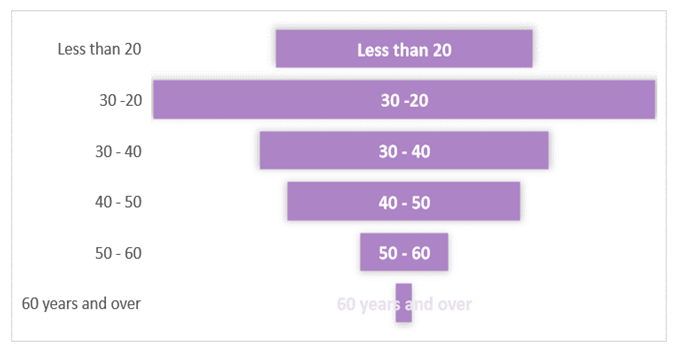 | Figure (1). Age |
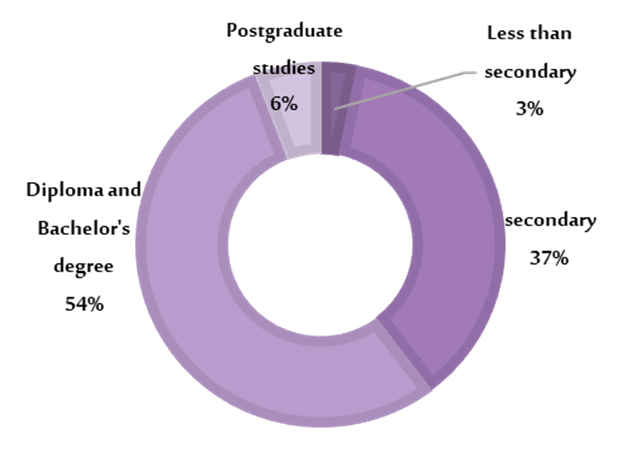 | Figure (2). Shows the educational level of the respondents |
 | Figure (3). Respondents Type of Occupation |
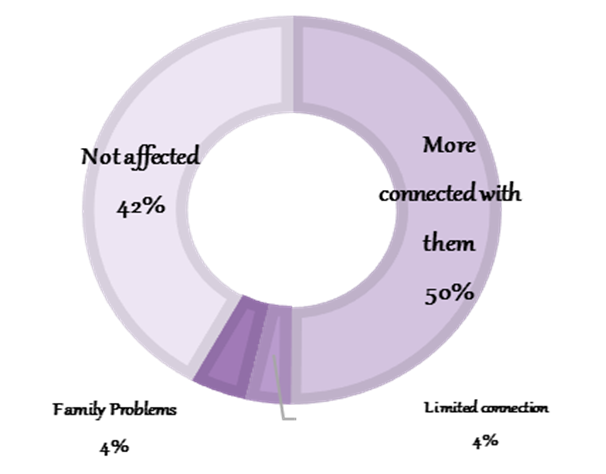 | Figure (4). Shows the impact of the COVID-19 on family Surrounding |
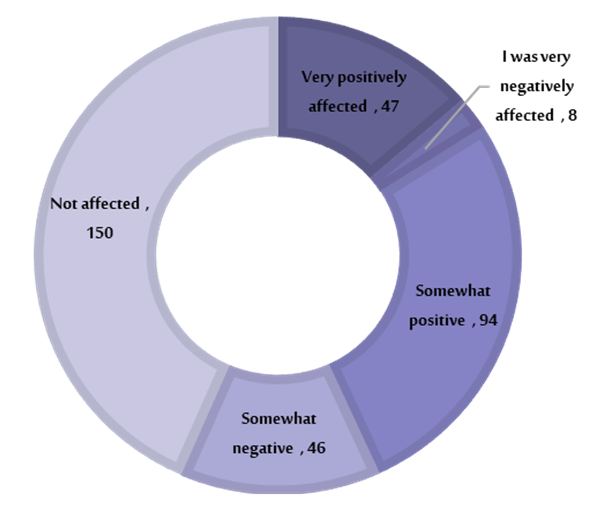 | Figure (5). Effect of Covid-19 on marital relations |
 | Figure (6). Bahraini Families Social Problems During COVID-19 Pandemic |
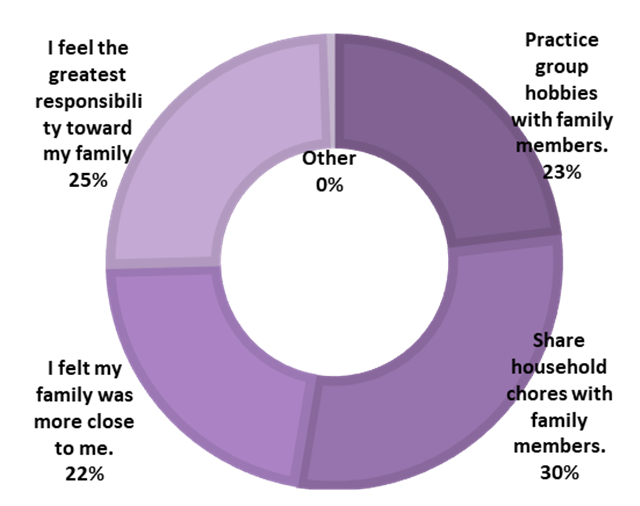 | Figure (7). Advantages of staying with family at home |
5. Findings
- The study aims at understanding how the influence of COVID-19 pandemic on the families fulfils the needs for care economy. The opportunities that epidemic crisis and its lockdown brings to the family bonding are analysed. The analysis shows that Covid-19 has a positive aspect of family relations in general, and it has a significant impact of 50% on strengthening the family care relationship between members of the nuclear family, especially. The findings also show that we can build positive family relations during the period of social isolation or lockdown and even strengthen family relations through assistance in domestic work and by practising collective hobbies with family members. The role of the extended family in preserving societal customs in light of the spread of the Covid-19 is also very clear. Despite the data shows that in Bahrain there was no significant changes in family domestic violence, or conflicts, or no increase in divorce rate; the literature review defies that this was not the case in most of the major countries in the world.
6. Conclusions
- The results of the study found that there is a significant positive care practice between family members due to social distancing that has resulted in strengthening relations between family members, in the extended families specifically, and in reducing social problems in society, in general, during the COVID-19 pandemic.The authors believe that more papers are needed to focus on the role of the family in flattening the mental health curve that is rising sharply due to a devastating pandemic that threatens life and livelihood. Realising the strengths and the weaknesses of this role during such unprecedented radical and dynamical change would help to address future coming global challenges more effectively and in feasible ways. The limitation of this paper is that the collected data was carried only in one country, i.e. Bahrain. Hence, more global studies are recommended to generalise the study results. The other limitation of this work is that it did not include the type of mental health risks or preventions that occurred as a result of the families’ status during the COVID-19 lockdown or social distancing. This is due to the constraints of the scope of the paper. The main implication of this study shed light on the importance of having a macro-study about the future foresight of the ‘care economy’ after the COVID-19 pandemic. The other implication this paper emphasises is the positive role of the extended families to mitigate the coming international crisis similar to COVID-19, or to mitigate such pandemic spillovers during the new normal.
 Abstract
Abstract Reference
Reference Full-Text PDF
Full-Text PDF Full-text HTML
Full-text HTML